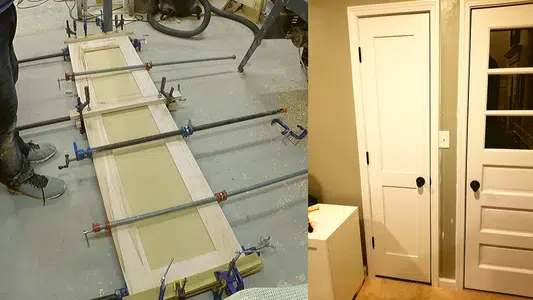Medium-density fiberboard (MDF) is a type of engineered wood that is commonly used in the production of interior doors. MDF doors have become increasingly popular due to their affordability and durability, but they also have their drawbacks. In this article, we will explore the pros and cons of MDF interior doors.
Pros of MDF Interior Doors
Affordability: MDF doors are generally less expensive than solid wood doors. This is because MDF is a composite material made from wood fibers and resin. Which makes it less expensive than solid wood.
Versatility: MDF doors can be painted or stained to look like any type of wood, making them a versatile option for homeowners who want the look of wood without the high price tag.
Durability: MDF is a very durable material, making it resistant to warping, cracking, and splitting. This makes MDF doors a good option for high-traffic areas, such as entryways, hallways, and closets.
Consistency: MDF doors are made from a uniform material, which means that they have a consistent texture and color throughout. This makes them a good option for homeowners who want a consistent look throughout their home.
Environmentally Friendly: MDF is made from recycled wood fibers, making it an environmentally friendly option for homeowners who are concerned about sustainability.
Cons of MDF Interior Doors
Susceptibility to Moisture: MDF doors are not recommended for use in high-moisture areas, such as bathrooms or kitchens. When exposed to moisture, MDF can swell and warp, causing the door to lose its shape.
Limited Design Options: MDF doors are limited in terms of design options, as they cannot be carved or routed like solid wood doors. This means that homeowners who want intricate designs may not be able to achieve the look they want with an MDF door.
Heavy Weight: MDF doors are heavier than hollow-core doors, which can make them more difficult to install. This can also be an issue for homeowners who want to change their doors frequently, as MDF doors may require more effort to remove and replace.
Not as Durable as Solid Wood: While MDF is a durable material, it is not as strong as solid wood. This means that MDF doors may not hold up as well over time, especially in high-traffic areas.
Not as Energy Efficient: MDF doors are not as energy-efficient as solid wood doors. This is because MDF is a poor insulator, which means that it may not provide the same level of insulation as a solid wood door.
Conclusion
MDF interior doors offer many benefits, including affordability, versatility, and durability. However, they also have their drawbacks, such as their susceptibility to moisture. Limited design options, heavy weight, and lower durability compared to solid wood doors. When selecting interior doors for your home, it’s important to consider your budget. Style preferences, and practical needs to determine whether. MDF doors are the right choice for you. If you’re looking for a budget-friendly option that can provide the look of wood without the high cost. MDF doors may be a good choice. However, if you want a more durable, energy-efficient option with more design flexibility, solid wood doors may be a better fit.

